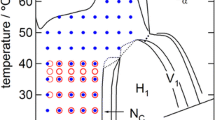Abstract
We investigate the rheological properties of a simplified version of a liquid detergent composed of an aqueous solution of the linear alkylbenzene sulphonate (LAS) surfactant, in which a small amount of fibers made of hydrogenated castor oil (HCO) is dispersed. At the concentration typically used in detergents, LAS is in a worm-like micellar phase exhibiting a Maxwellian behavior. The presence of HCO fibers provides elastic properties, such that the system behaves as a simple Zener body, mechanically characterized by a parallel connection of a spring and a Maxwell element. Despite this apparent independence of the contributions of the fibers and the surfactant medium to the mechanical characteristics of the system, we find that the low frequency modulus increases with increasing LAS concentration. This indicates that LAS induces attractive interactions among the HCO fibers, resulting in the formation of a stress-bearing structure that withstands shear at HCO concentrations, where the HCO fibers in the absence of attractive interactions would not sufficiently overlap to provide stress-bearing properties to the system.







Similar content being viewed by others
References
Larson RG (1999) The structure and rheology of complex fluids. Oxford University Press, New York
Israelachvili JN, Mitchell DJ, Ninham BW (1975) Theory of self-assembly of hydrocarbon amphiphiles. J Chem Soc Faraday Trans 2 72:1525–1568
Gaudino D, Pasquino R, Grizzuti N (2015) Adding salt to a surfactant solution: linear rheological response of the resulting morphologies. J Rheol 59:1363–1375
Solomon MJ, Spicer PT (2010) Microstructural regimes of colloidal rod suspensions, gels, and glasses. Soft Matter 6:1391–1400
Gardel ML, Shin JH, MacKintosh FC, Mahadevan L, Matsudaira PA, Weitz DA (2014) Scaling of F-actin network rheology to probe single filament elasticity and dynamics. Phys Rev Lett 93:188102-1-188102-4
Broedersz CP, MacKintosh FC (2014) Modeling semiflexible polymer networks. Rev Mod Phys 86:995–1036
Ezzellt SA, McCormick CL (1992) Water-soluble copolymers. 39. Synthesis and solution properties of associative acrylamido copolymers with pyrenesulfonamide fluorescence labels. Macromolecules 25:1881–1886
García-Ochoa F, Santos VE, Casas JA, Gómez E (2000) Xanthan gum: production, recovery, and properties. Biotechnol Adv 18:549–579
Karlsona L, Joabssonb F, Thuressonb K (2000) Phase behavior and rheology in water and in model paint formulations thickened with HM-EHEC: influence of the chemical structure and the distribution of hydrophobic tails. Carbohydr Polym 41:25–35
Habibi Y, Lucia LA, Rojas OJ (2010) Cellulose nanocrystals: chemistry, self-assembly, and applications. Chem Rev 110:3479–3500
Derjaguin B, Landau L (1941) Theory of the stability of strongly charged lyophobic sols and of the adhesion of strongly charged particles in solution of electrolytes. Acta Physicochim 14:633–662
Verwey EJW, Overbeek JTG (1947) Theory of stability of lyophobic colloids. J Phys Chem 51:631–636
Langmuir I (1938) The role of attractive and repulsive forces in the formation of tactoids, thixotropic gels, protein crystals and coacervates. J Chem Phys 6:873–896
De Meirleir N, Pellens L, Broeckx W, van Assche G, De Malsche W (2014) The rheological properties of hydrogenated castor oil crystals. Colloid Polym Sci 292:2539–2547
Yang D, Hrymak AN (2013) Rheology of aqueous dispersions of hydrogenated castor oil. Appl Rheol 23:23622-1-23622-9
De Meirleir N, Broeckx W, Puyvelde PV, De Malsche W (2015) Surfactant assisted emulsion crystallization of hydrogenated castor oil. Cryst Growth Des 15:635–641
Dreiss CA, Nwabunwanne E, Liua R, Brooks NJ (2009) Assembling and de-assembling micelles: competitive interactions of cyclodextrins and drugs with pluronics. Soft Matter 5:1888–1896
Oelschlaeger C, Schopferer M, Scheffold F, Willenbacher N (2009) Linear-to-branched micelles transition: a rheometry and diffusing wave spectroscopy (dws) study. Langmuir 25:716–723
Lutz Bueno V, Pasquino R, Liebi M, Kohlbrecher J, Fischer P (2016) Viscoelasticity enhancement of surfactant solutions depends on molecular conformation: influence of surfactant headgroup structure and its counterion. Langmuir 32:4239–4250
Cates ME, Candau SJ (1990) Statics and dynamics of worm-like surfactant micelles. J Phys Condens Matter 2:6869–6892
Dreiss CA (2007) Wormlike micelles: where do we stand? Recent developments, linear rheology and scattering techniques. Soft Matter 3:956–970
Trappe V, Weitz DA (2000) Scaling of the viscoelasticity of weakly attractive particles. Phys Rev Lett 85:449–452
Poon WCK (2002) The physics of a model colloid–polymer mixture. J Phys Condens Matter 14:R859–R880
Schuldt C, Schnau ßJ, Händler T, Glaser M, Lorenz J, Golde T, Käs JA, Smith D (2016) Tuning synthetic semiflexible networks by bending stiffness. Phys Rev Lett 117:197801-1–197801-6
Gardel ML, Shin JH, MacKintosh FC, Mahadevan L, Matsudaira P, Weitz DA (2004) Elastic behavior of cross-linked and bundled actin networks. Science 304:1301–1305
Doi M, Edwards SF (1986) The theory of polymer dynamics. Clarendon Press, Oxford
Tharmann R, Claessens MMAE, Bausch AR (2006) Micro- and macrorheological properties of actin networks effectively cross-linked by depletion forces. Biophys J 90:2622–2627
Wilkins GMH, Spicer PT, Solomon MJ (2009) Colloidal system to explore structural and dynamical transitions in rod networks, gels, and glasses. Langmuir 25:8951–8959
Kazem N, Majidi C, Maloney C (2015) Gelation and mechanical response of patchy rods. Soft Matter 11:7877–7887
Acknowledgements
We thank P&G for the materials and for financial support to G.Z. and S.M..
Author information
Authors and Affiliations
Corresponding author
Ethics declarations
Conflict of interest
The authors declare that they have no conflict of interest.
Rights and permissions
About this article
Cite this article
Zanchetta, G., Mirzaagha, S., Guida, V. et al. Colloidal fibers as structurant for worm-like micellar solutions. Colloid Polym Sci 296, 1379–1385 (2018). https://doi.org/10.1007/s00396-018-4357-0
Received:
Revised:
Accepted:
Published:
Issue Date:
DOI: https://doi.org/10.1007/s00396-018-4357-0




